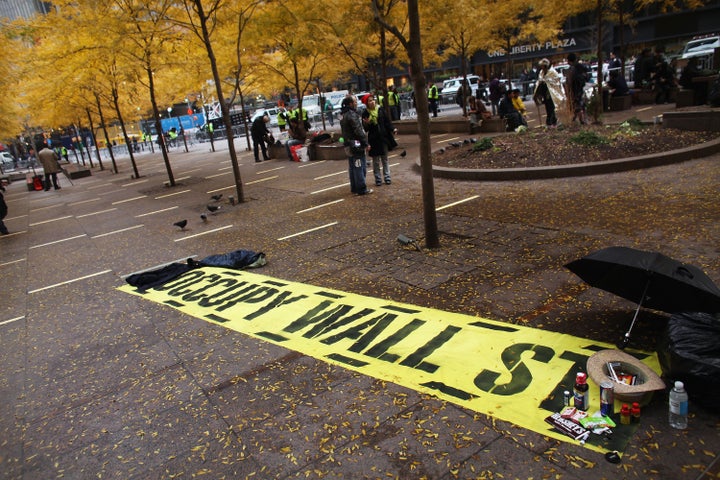
The police raids of the past week are raising questions about the future of Occupy Wall Street. Without the Zuccotti Park encampment that was at the heart of the movement, will it fade away? Will harsh weather or police violence drive people away?
Not likely. It will almost certainly evolve and change form, but the movement has a great deal of built-in resilience. It is radically decentralized, so a disaster at any one occupation will not bring down the others; in fact, others groups can and do take action in support. There is no single leader who could be co-opted or assassinated. Instead, leadership is broadly shared, and leadership skills are being taught and learned constantly.
Losing an occupation site like Zuccotti Park doesn't mean losing the ability to organize. Social media keeps people in touch. General assemblies can happen without 24/7 occupations, as can marches and sit-ins at eviction courts, foreclosed buildings, and bank lobbies.
And police violence is backfiring. Outrage is widespread over the pepper spraying of an elderly woman at Occupy Seattle and of seated Berkeley students, and other over-the-top police action. Popular outrage is further fueling the movement.
Because they are each autonomous, the Occupy groups that plan and carry out a wide range of direct actions are extremely difficult to contain. By choosing the targets of their actions wisely, occupiers are directing attention to institutions, like Wall Street banks, that are harming the 99 percent. When the legitimacy of large institutions crumbles, it is often just a matter of time before the support of government, stockholders, customers, and employees goes away, too. There is no institution that is "too big to fail." This is one way that nonviolent revolution happens.
Reinforcements
Meanwhile, new support is flowing in, some from unexpected sources. Veterans--many of whom face joblessness and even homelessness when discharged from the military--are showing up, claiming their membership in the 99 percent. Marines especially were inspired by a viral video showing Marine Sergeant Shamar Thomas dressing down the police for brutalizing protesters. "There is no honor in this," he shouted at the police. The wounding of Marine veteran Scott Olsen, who at 24 had already served two tours in Iraq, has further fired up fellow veterans.
Even some police--though often shown suppressing occupations -- have quietly expressed sympathy for the movement. Retired Philadelphia Police captain Ray Lewis was recently arrested in New York where he was protesting holding a sign reading: "NYPD Don't be Wall Street Mercenaries."
If popular support grows, will elected officials look to ally themselves with the movement, rather than suppress it? Might there come a time when there is no one willing to pepper spray, beat, and otherwise evict members of the 99% from occupation encampments -- or from their homes?
The fact that these are even questions shows how radically things have changed since a few hundred people occupied Zuccotti Park on September 17, 2011.
The future of the movement may not hinge on violent police raids or harsh weather. The key may be whether the movement will be able to contain or repudiate acts of violence instigated by tiny groups within its own ranks -- or by provocateurs. Within a month of the movement's launch an admitted provocateur, an assistant editor at the right-wing magazine American Spectator, tried, without success, to get Occupy and anti-war protesters to join him in pushing past security guards at the Smithsonian Museum of Air and Space in Washington, D.C. The crowd refused to follow, but most news reports still attributed the scuffle to Occupy Wall Street protesters. In Oakland, a general strike that brought thousands to the streets and shut down the port was marred by a small group who smashed windows and spray painted buildings, in spite of desperate efforts by other protesters to prevent the vandalism.
"It's kind of a miracle."
Whatever happens next, Occupy Wall Street has already accomplished something that changes everything. It has fundamentally altered the national conversation. Now that millions recognize the injustice resulting from the power of Wall Street and giant corporations, that issue will not go away. The movement has made this the central question in the mind of millions: Will we build a society to benefit everyone? Or just the 1 percent? This question will be the subtext for the election season and for policy debates at all levels of government.
"A group of people started camping out in Zuccotti Park, and all of a sudden the conversation started being about the right things," says New York Times columnist Paul Krugman. "It's kind of a miracle."
The world becomes a very different place when members of the 99 percent stood up. The revolts in Egypt, elsewhere in the Middle East, and in Europe belie the story that popular uprisings are futile. The people who occupied Zuccotti Park in lower Manhattan and are still occupying public spaces across the country show that Americans, too, can take a stand.
People who've experienced the power of having a voice will not easily go back to silence. People who've found political self-respect will work hard to avoid a return to isolation and powerlessness. The 99% are no longer sitting on the sidelines of history. The Occupy Wall Street movement gives us reason to believe that we the people can take charge of our destinies.
__________________________________
Sarah van Gelder is co-founder and executive editor of YES! Magazine. This article is excerpted and adapted from the introduction to the book This Changes Everything: Occupy Wall Street and the 99% Movement edited by Sarah van Gelder and the staff of YES! Magazine and published by Berrett-Koehler Publishers.
Note: This piece is available for free copying and reproduction under a Creative Commons Attribution NoDerivs (CC BY-ND) license, which allows for redistribution, commercial and non-commercial, as long as it is passed along unchanged and in whole, with credit to its original publication in the book, This Changes Everything: Occupy Wall Street and the 99% Movement, Berrett-Koehler Publishers, 2011.
Interested?
Follow YES! Magazine's ongoing coverage of Occupy Wall Street
10 Ways to Support the Occupy Movement
There are many things you can do to be part of this growing movement--and only some of them involve sleeping outside.
How to Build a People's Movement
Now's the time to challenge economic orthodoxy--but only a massive social movement can turn things around..
